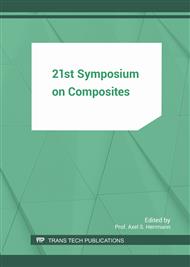[1]
Lässig R, Eisenhut M, Mathias A, Schulte RT, Peters F, Kühmann T et al. Serienproduktion von hochfesten Faserverbundbauteilen: Perspektiven für den deutschen Maschinen- und Anlagenbau. Studie.
Google Scholar
[2]
Ding A, Li S, Sun J, Wang J, Zu L. A thermo-viscoelastic model of process-induced residual stresses in composite structures with considering thermal dependence. Composite Structures 2016; 136: 34–43.
DOI: 10.1016/j.compstruct.2015.09.014
Google Scholar
[3]
Fauster E, Schledjewski R. A Model-Based Processing Concept for Thermoplastic Tape Placement. In: Proceedings of SAMPE 2012, Baltimore, USA, (2012).
Google Scholar
[4]
Konstantopolous S, Fauster E, Schledjewski R. An Adaptive Modular Monitoring & Control System for Composites Manufacturing Processes. In: Proceedings of The 34th International Symposium on Materials Science (ISMS), Risø, Denmark, (2013).
Google Scholar
[5]
Fauster E, Hergan P, Schledjewski R. HybridRTM - Quality Controlled Manufacturing of Hybrid Material Composites through Resin Transfer Moulding. In: Proceedings of Euro Hybrid 2 - Materials and Structures, Kaiserslautern, Germany, (2016).
DOI: 10.4028/www.scientific.net/kem.742.527
Google Scholar
[6]
Peng Z, Nie X. Galvanic corrosion property of contacts between carbon fiber cloth materials and typical metal alloys in an aggressive environment. Surface and Coatings Technology 2013; 215: 85–9.
DOI: 10.1016/j.surfcoat.2012.08.098
Google Scholar
[7]
Ireland R, Arronche L, La Saponara V. Electrochemical investigation of galvanic corrosion between aluminum 7075 and glass fiber/epoxy composites modified with carbon nanotubes. Composites Part B: Engineering 2012; 43(2): 183–94.
DOI: 10.1016/j.compositesb.2011.08.001
Google Scholar
[8]
Lauermann M. A high temperature heat pump with HFO-1336mzz(Z) as the working fluid: Performance Simulations and Measurements. In: Chillventa, Nürnberg, Germany, (2016).
Google Scholar
[9]
Shin KC, Lee JJ. Effects of thermal residual stresses on failure of co-cured lap joints with steel and carbon fiber-epoxy composite adherends under static and fatigue tensile loads. Composites Part A: Applied Science and Manufacturing 2006; 37(3): 476–87.
DOI: 10.1016/j.compositesa.2005.03.031
Google Scholar
[10]
Shin KC, Lee JJ. Prediction of the tensile load-bearing capacity of a co-cured single lap joint considering residual thermal stresses. Journal of Adhesion Science and Technology 2000; 14(13): 1691–704.
DOI: 10.1163/156856100742492
Google Scholar
[11]
Gou J, Zhang C, Liang Z, Wang B, Simpson J. Resin Transfer Molding Process Optimization Using Numerical Simulation and Design of Experiments Approach. Polymer Composites 2003; 24(1): 1–12.
DOI: 10.1002/pc.10000
Google Scholar
[12]
Hergan P, Fauster E, Schledjewski R. A model-based concept for an optimized resin transfer moulding process. In: European Society of Composite Materials, editor. Proceedings of 17th European Conference on Composite Materials, Munich, Germany, 2016; (2016).
DOI: 10.1088/1757-899x/406/1/012060
Google Scholar


